Analyzing Data and Information for Business Decisions in Retail
VerifiedAdded on 2021/01/01
|8
|2256
|475
Report
AI Summary
This report provides a comprehensive overview of the role of data and information in the retail industry. It begins by defining data and information, emphasizing their significance in business decision-making. The report then explores the impact of globalization and the increasing complexity of the retail market, highlighting the need for advanced retail information systems. It delves into different types of data used, including primary and secondary sources, and explains various database management information systems. The report also examines how market research and management information systems (MIS) are utilized to gain business insights and make informed decisions, including the use of data analytics to understand customer behavior. The conclusion emphasizes the importance of maintaining and interpreting information to achieve a competitive advantage in the rapidly evolving retail landscape.

RETAIL INDUSTRY
Paraphrase This Document
Need a fresh take? Get an instant paraphrase of this document with our AI Paraphraser
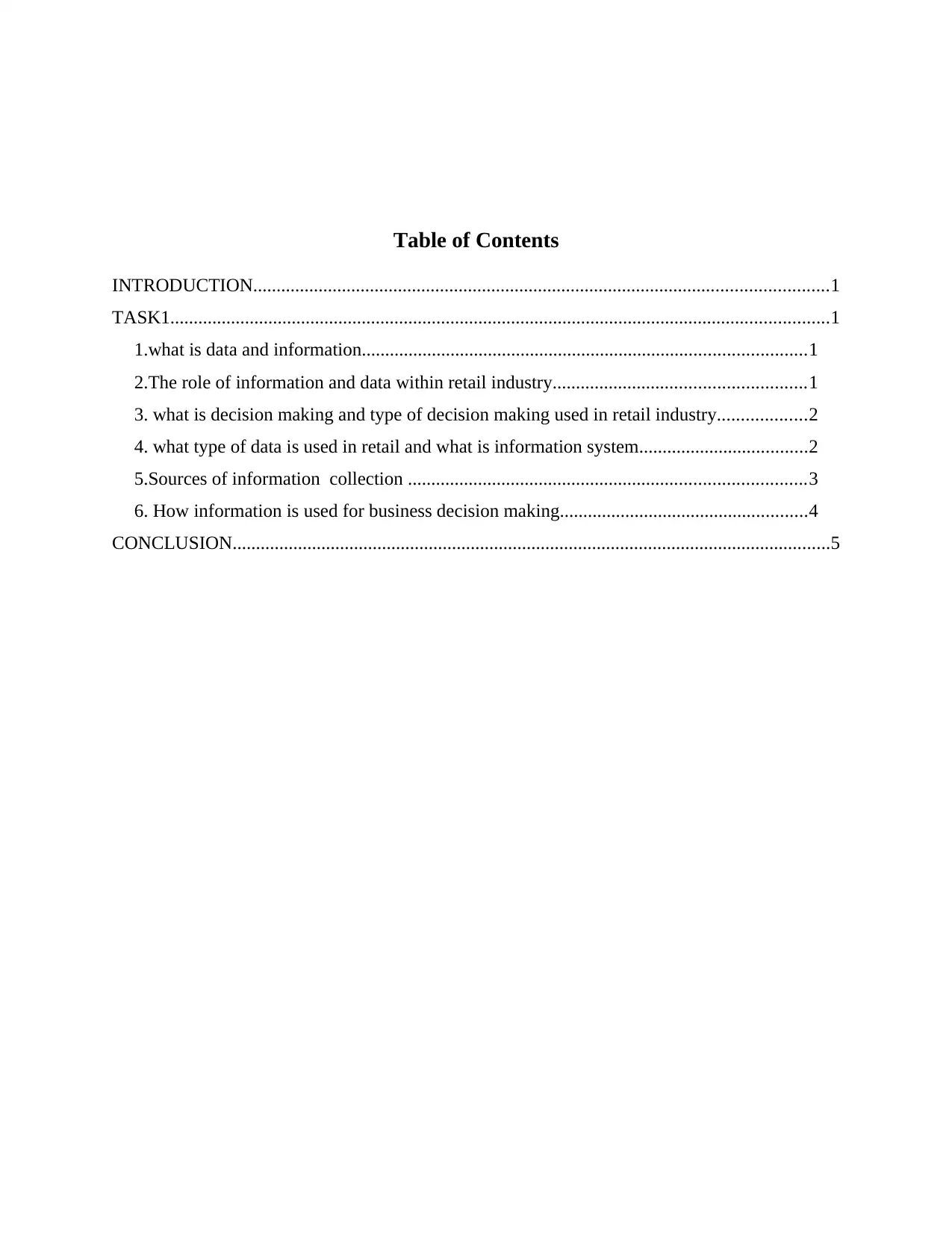
Table of Contents
INTRODUCTION...........................................................................................................................1
TASK1.............................................................................................................................................1
1.what is data and information...............................................................................................1
2.The role of information and data within retail industry......................................................1
3. what is decision making and type of decision making used in retail industry...................2
4. what type of data is used in retail and what is information system....................................2
5.Sources of information collection .....................................................................................3
6. How information is used for business decision making.....................................................4
CONCLUSION................................................................................................................................5
INTRODUCTION...........................................................................................................................1
TASK1.............................................................................................................................................1
1.what is data and information...............................................................................................1
2.The role of information and data within retail industry......................................................1
3. what is decision making and type of decision making used in retail industry...................2
4. what type of data is used in retail and what is information system....................................2
5.Sources of information collection .....................................................................................3
6. How information is used for business decision making.....................................................4
CONCLUSION................................................................................................................................5
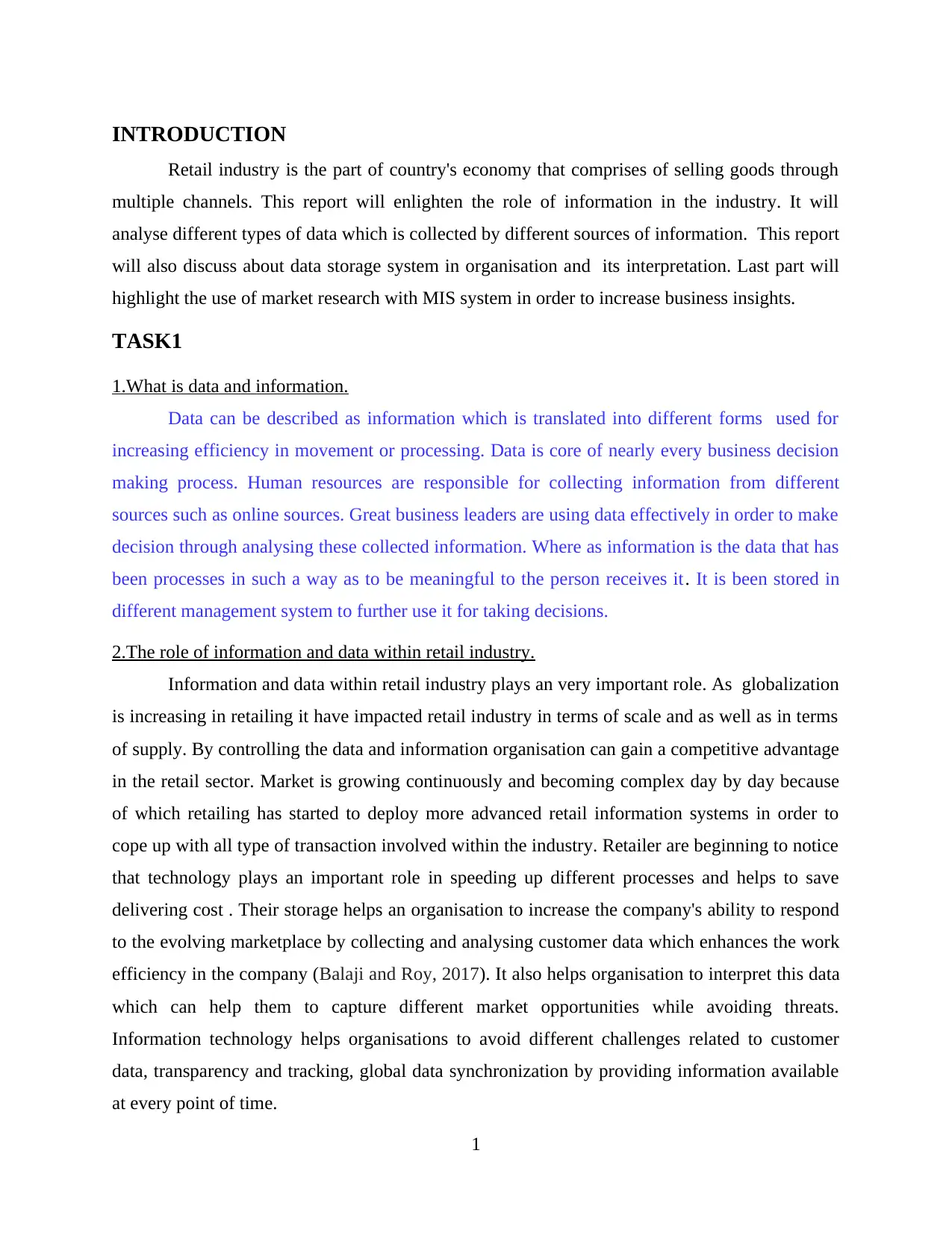
INTRODUCTION
Retail industry is the part of country's economy that comprises of selling goods through
multiple channels. This report will enlighten the role of information in the industry. It will
analyse different types of data which is collected by different sources of information. This report
will also discuss about data storage system in organisation and its interpretation. Last part will
highlight the use of market research with MIS system in order to increase business insights.
TASK1
1.What is data and information.
Data can be described as information which is translated into different forms used for
increasing efficiency in movement or processing. Data is core of nearly every business decision
making process. Human resources are responsible for collecting information from different
sources such as online sources. Great business leaders are using data effectively in order to make
decision through analysing these collected information. Where as information is the data that has
been processes in such a way as to be meaningful to the person receives it. It is been stored in
different management system to further use it for taking decisions.
2.The role of information and data within retail industry.
Information and data within retail industry plays an very important role. As globalization
is increasing in retailing it have impacted retail industry in terms of scale and as well as in terms
of supply. By controlling the data and information organisation can gain a competitive advantage
in the retail sector. Market is growing continuously and becoming complex day by day because
of which retailing has started to deploy more advanced retail information systems in order to
cope up with all type of transaction involved within the industry. Retailer are beginning to notice
that technology plays an important role in speeding up different processes and helps to save
delivering cost . Their storage helps an organisation to increase the company's ability to respond
to the evolving marketplace by collecting and analysing customer data which enhances the work
efficiency in the company (Balaji and Roy, 2017). It also helps organisation to interpret this data
which can help them to capture different market opportunities while avoiding threats.
Information technology helps organisations to avoid different challenges related to customer
data, transparency and tracking, global data synchronization by providing information available
at every point of time.
1
Retail industry is the part of country's economy that comprises of selling goods through
multiple channels. This report will enlighten the role of information in the industry. It will
analyse different types of data which is collected by different sources of information. This report
will also discuss about data storage system in organisation and its interpretation. Last part will
highlight the use of market research with MIS system in order to increase business insights.
TASK1
1.What is data and information.
Data can be described as information which is translated into different forms used for
increasing efficiency in movement or processing. Data is core of nearly every business decision
making process. Human resources are responsible for collecting information from different
sources such as online sources. Great business leaders are using data effectively in order to make
decision through analysing these collected information. Where as information is the data that has
been processes in such a way as to be meaningful to the person receives it. It is been stored in
different management system to further use it for taking decisions.
2.The role of information and data within retail industry.
Information and data within retail industry plays an very important role. As globalization
is increasing in retailing it have impacted retail industry in terms of scale and as well as in terms
of supply. By controlling the data and information organisation can gain a competitive advantage
in the retail sector. Market is growing continuously and becoming complex day by day because
of which retailing has started to deploy more advanced retail information systems in order to
cope up with all type of transaction involved within the industry. Retailer are beginning to notice
that technology plays an important role in speeding up different processes and helps to save
delivering cost . Their storage helps an organisation to increase the company's ability to respond
to the evolving marketplace by collecting and analysing customer data which enhances the work
efficiency in the company (Balaji and Roy, 2017). It also helps organisation to interpret this data
which can help them to capture different market opportunities while avoiding threats.
Information technology helps organisations to avoid different challenges related to customer
data, transparency and tracking, global data synchronization by providing information available
at every point of time.
1
⊘ This is a preview!⊘
Do you want full access?
Subscribe today to unlock all pages.

Trusted by 1+ million students worldwide
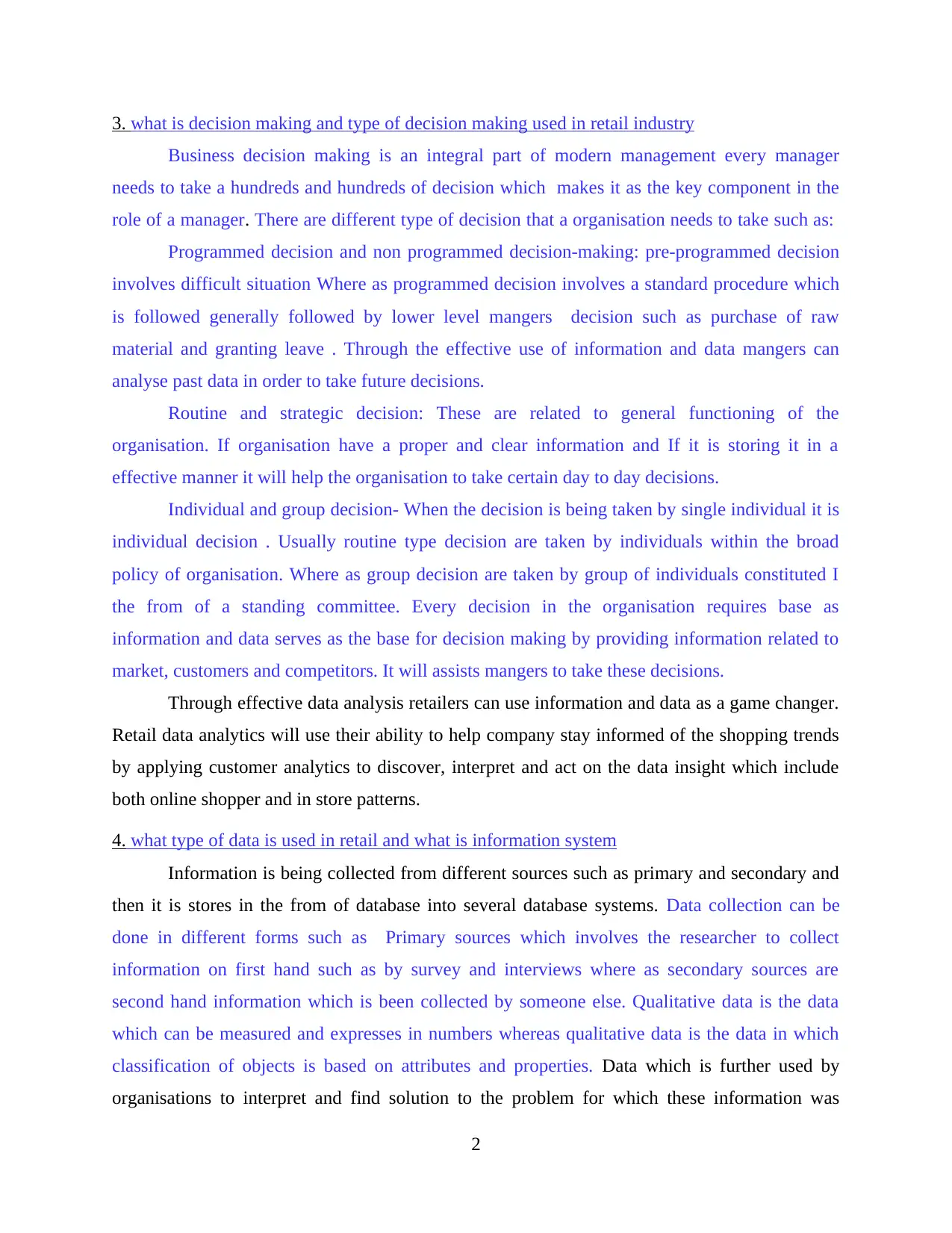
3. what is decision making and type of decision making used in retail industry
Business decision making is an integral part of modern management every manager
needs to take a hundreds and hundreds of decision which makes it as the key component in the
role of a manager. There are different type of decision that a organisation needs to take such as:
Programmed decision and non programmed decision-making: pre-programmed decision
involves difficult situation Where as programmed decision involves a standard procedure which
is followed generally followed by lower level mangers decision such as purchase of raw
material and granting leave . Through the effective use of information and data mangers can
analyse past data in order to take future decisions.
Routine and strategic decision: These are related to general functioning of the
organisation. If organisation have a proper and clear information and If it is storing it in a
effective manner it will help the organisation to take certain day to day decisions.
Individual and group decision- When the decision is being taken by single individual it is
individual decision . Usually routine type decision are taken by individuals within the broad
policy of organisation. Where as group decision are taken by group of individuals constituted I
the from of a standing committee. Every decision in the organisation requires base as
information and data serves as the base for decision making by providing information related to
market, customers and competitors. It will assists mangers to take these decisions.
Through effective data analysis retailers can use information and data as a game changer.
Retail data analytics will use their ability to help company stay informed of the shopping trends
by applying customer analytics to discover, interpret and act on the data insight which include
both online shopper and in store patterns.
4. what type of data is used in retail and what is information system
Information is being collected from different sources such as primary and secondary and
then it is stores in the from of database into several database systems. Data collection can be
done in different forms such as Primary sources which involves the researcher to collect
information on first hand such as by survey and interviews where as secondary sources are
second hand information which is been collected by someone else. Qualitative data is the data
which can be measured and expresses in numbers whereas qualitative data is the data in which
classification of objects is based on attributes and properties. Data which is further used by
organisations to interpret and find solution to the problem for which these information was
2
Business decision making is an integral part of modern management every manager
needs to take a hundreds and hundreds of decision which makes it as the key component in the
role of a manager. There are different type of decision that a organisation needs to take such as:
Programmed decision and non programmed decision-making: pre-programmed decision
involves difficult situation Where as programmed decision involves a standard procedure which
is followed generally followed by lower level mangers decision such as purchase of raw
material and granting leave . Through the effective use of information and data mangers can
analyse past data in order to take future decisions.
Routine and strategic decision: These are related to general functioning of the
organisation. If organisation have a proper and clear information and If it is storing it in a
effective manner it will help the organisation to take certain day to day decisions.
Individual and group decision- When the decision is being taken by single individual it is
individual decision . Usually routine type decision are taken by individuals within the broad
policy of organisation. Where as group decision are taken by group of individuals constituted I
the from of a standing committee. Every decision in the organisation requires base as
information and data serves as the base for decision making by providing information related to
market, customers and competitors. It will assists mangers to take these decisions.
Through effective data analysis retailers can use information and data as a game changer.
Retail data analytics will use their ability to help company stay informed of the shopping trends
by applying customer analytics to discover, interpret and act on the data insight which include
both online shopper and in store patterns.
4. what type of data is used in retail and what is information system
Information is being collected from different sources such as primary and secondary and
then it is stores in the from of database into several database systems. Data collection can be
done in different forms such as Primary sources which involves the researcher to collect
information on first hand such as by survey and interviews where as secondary sources are
second hand information which is been collected by someone else. Qualitative data is the data
which can be measured and expresses in numbers whereas qualitative data is the data in which
classification of objects is based on attributes and properties. Data which is further used by
organisations to interpret and find solution to the problem for which these information was
2
Paraphrase This Document
Need a fresh take? Get an instant paraphrase of this document with our AI Paraphraser
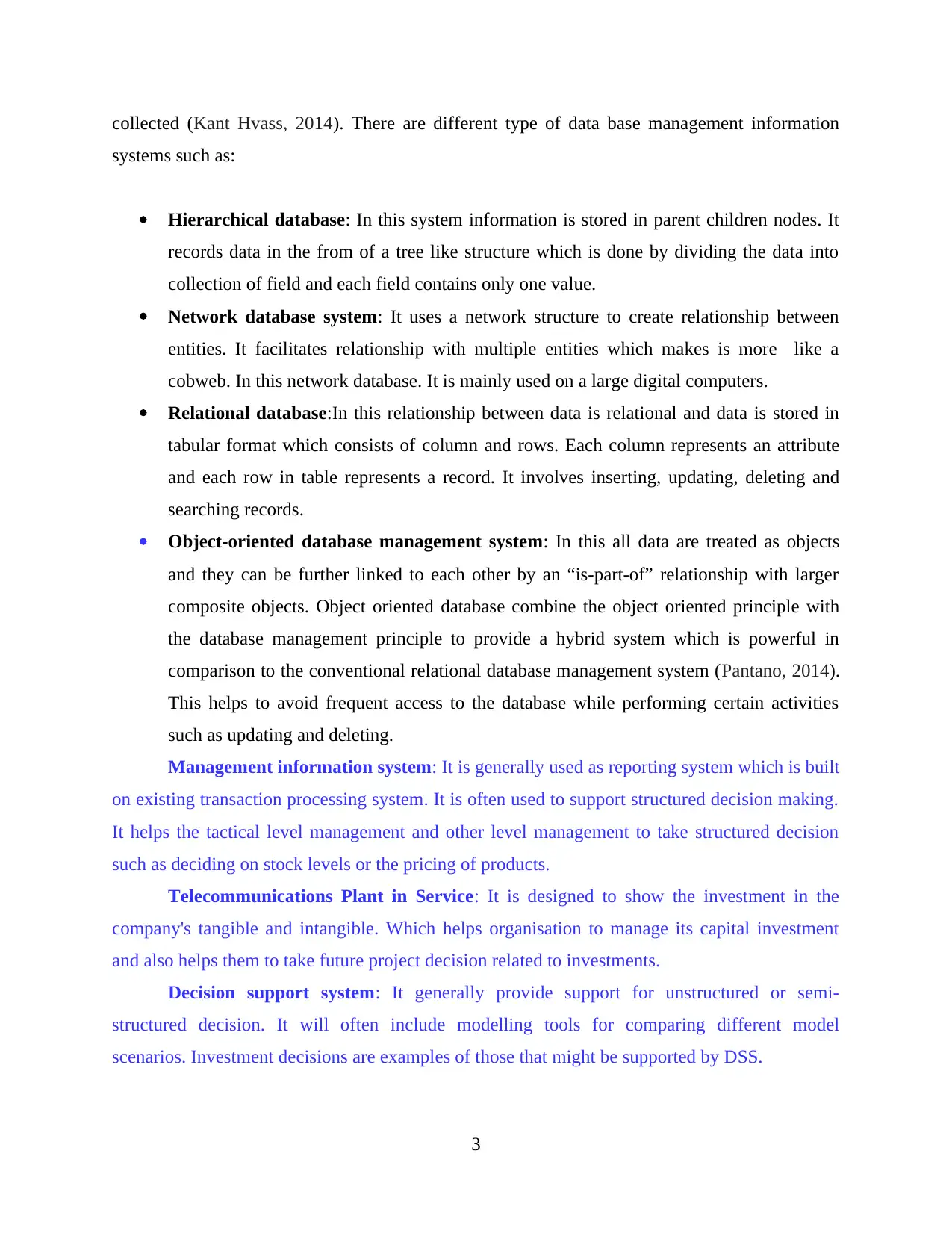
collected (Kant Hvass, 2014). There are different type of data base management information
systems such as:
Hierarchical database: In this system information is stored in parent children nodes. It
records data in the from of a tree like structure which is done by dividing the data into
collection of field and each field contains only one value.
Network database system: It uses a network structure to create relationship between
entities. It facilitates relationship with multiple entities which makes is more like a
cobweb. In this network database. It is mainly used on a large digital computers.
Relational database:In this relationship between data is relational and data is stored in
tabular format which consists of column and rows. Each column represents an attribute
and each row in table represents a record. It involves inserting, updating, deleting and
searching records.
Object-oriented database management system: In this all data are treated as objects
and they can be further linked to each other by an “is-part-of” relationship with larger
composite objects. Object oriented database combine the object oriented principle with
the database management principle to provide a hybrid system which is powerful in
comparison to the conventional relational database management system (Pantano, 2014).
This helps to avoid frequent access to the database while performing certain activities
such as updating and deleting.
Management information system: It is generally used as reporting system which is built
on existing transaction processing system. It is often used to support structured decision making.
It helps the tactical level management and other level management to take structured decision
such as deciding on stock levels or the pricing of products.
Telecommunications Plant in Service: It is designed to show the investment in the
company's tangible and intangible. Which helps organisation to manage its capital investment
and also helps them to take future project decision related to investments.
Decision support system: It generally provide support for unstructured or semi-
structured decision. It will often include modelling tools for comparing different model
scenarios. Investment decisions are examples of those that might be supported by DSS.
3
systems such as:
Hierarchical database: In this system information is stored in parent children nodes. It
records data in the from of a tree like structure which is done by dividing the data into
collection of field and each field contains only one value.
Network database system: It uses a network structure to create relationship between
entities. It facilitates relationship with multiple entities which makes is more like a
cobweb. In this network database. It is mainly used on a large digital computers.
Relational database:In this relationship between data is relational and data is stored in
tabular format which consists of column and rows. Each column represents an attribute
and each row in table represents a record. It involves inserting, updating, deleting and
searching records.
Object-oriented database management system: In this all data are treated as objects
and they can be further linked to each other by an “is-part-of” relationship with larger
composite objects. Object oriented database combine the object oriented principle with
the database management principle to provide a hybrid system which is powerful in
comparison to the conventional relational database management system (Pantano, 2014).
This helps to avoid frequent access to the database while performing certain activities
such as updating and deleting.
Management information system: It is generally used as reporting system which is built
on existing transaction processing system. It is often used to support structured decision making.
It helps the tactical level management and other level management to take structured decision
such as deciding on stock levels or the pricing of products.
Telecommunications Plant in Service: It is designed to show the investment in the
company's tangible and intangible. Which helps organisation to manage its capital investment
and also helps them to take future project decision related to investments.
Decision support system: It generally provide support for unstructured or semi-
structured decision. It will often include modelling tools for comparing different model
scenarios. Investment decisions are examples of those that might be supported by DSS.
3
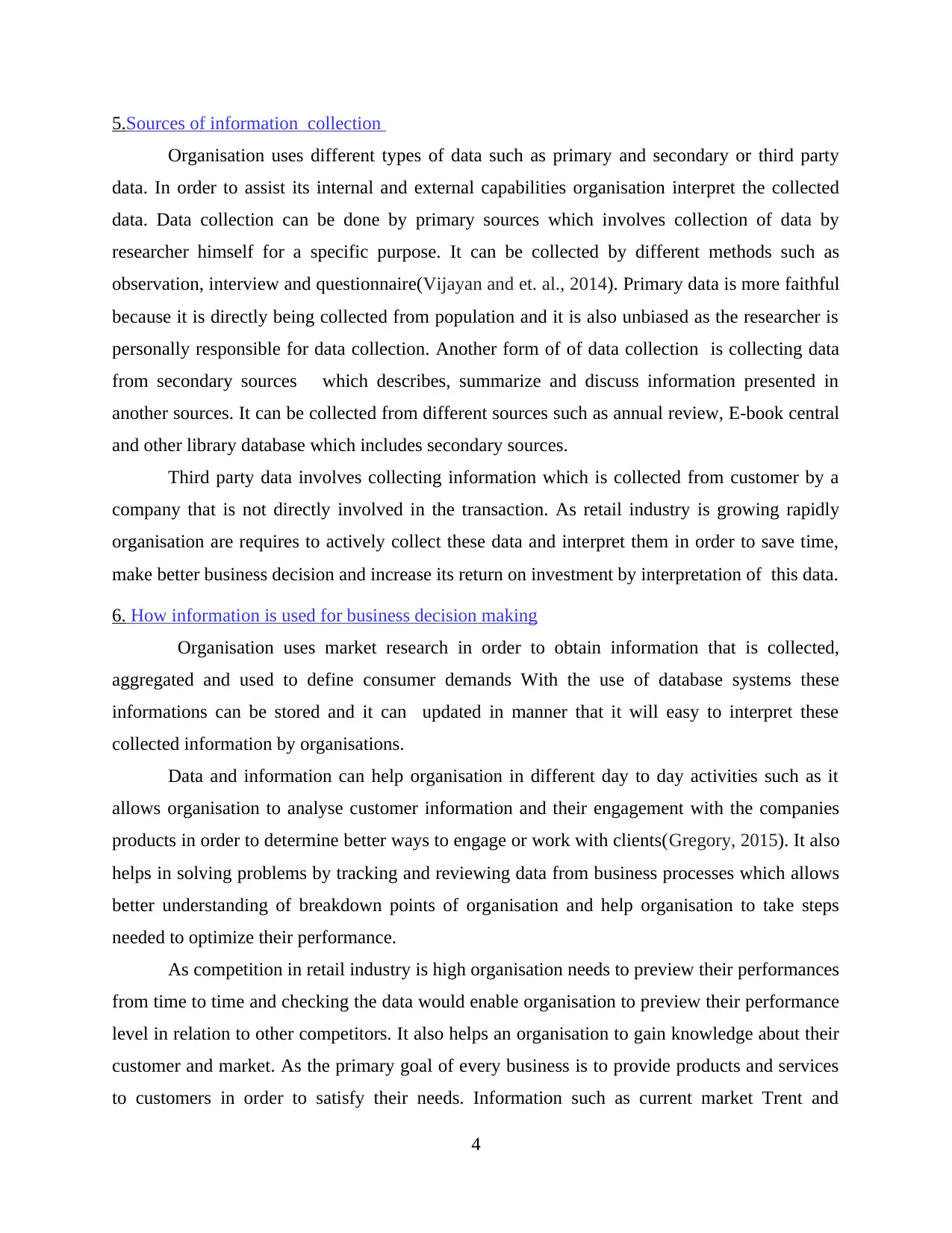
5.Sources of information collection
Organisation uses different types of data such as primary and secondary or third party
data. In order to assist its internal and external capabilities organisation interpret the collected
data. Data collection can be done by primary sources which involves collection of data by
researcher himself for a specific purpose. It can be collected by different methods such as
observation, interview and questionnaire(Vijayan and et. al., 2014). Primary data is more faithful
because it is directly being collected from population and it is also unbiased as the researcher is
personally responsible for data collection. Another form of of data collection is collecting data
from secondary sources which describes, summarize and discuss information presented in
another sources. It can be collected from different sources such as annual review, E-book central
and other library database which includes secondary sources.
Third party data involves collecting information which is collected from customer by a
company that is not directly involved in the transaction. As retail industry is growing rapidly
organisation are requires to actively collect these data and interpret them in order to save time,
make better business decision and increase its return on investment by interpretation of this data.
6. How information is used for business decision making
Organisation uses market research in order to obtain information that is collected,
aggregated and used to define consumer demands With the use of database systems these
informations can be stored and it can updated in manner that it will easy to interpret these
collected information by organisations.
Data and information can help organisation in different day to day activities such as it
allows organisation to analyse customer information and their engagement with the companies
products in order to determine better ways to engage or work with clients(Gregory, 2015). It also
helps in solving problems by tracking and reviewing data from business processes which allows
better understanding of breakdown points of organisation and help organisation to take steps
needed to optimize their performance.
As competition in retail industry is high organisation needs to preview their performances
from time to time and checking the data would enable organisation to preview their performance
level in relation to other competitors. It also helps an organisation to gain knowledge about their
customer and market. As the primary goal of every business is to provide products and services
to customers in order to satisfy their needs. Information such as current market Trent and
4
Organisation uses different types of data such as primary and secondary or third party
data. In order to assist its internal and external capabilities organisation interpret the collected
data. Data collection can be done by primary sources which involves collection of data by
researcher himself for a specific purpose. It can be collected by different methods such as
observation, interview and questionnaire(Vijayan and et. al., 2014). Primary data is more faithful
because it is directly being collected from population and it is also unbiased as the researcher is
personally responsible for data collection. Another form of of data collection is collecting data
from secondary sources which describes, summarize and discuss information presented in
another sources. It can be collected from different sources such as annual review, E-book central
and other library database which includes secondary sources.
Third party data involves collecting information which is collected from customer by a
company that is not directly involved in the transaction. As retail industry is growing rapidly
organisation are requires to actively collect these data and interpret them in order to save time,
make better business decision and increase its return on investment by interpretation of this data.
6. How information is used for business decision making
Organisation uses market research in order to obtain information that is collected,
aggregated and used to define consumer demands With the use of database systems these
informations can be stored and it can updated in manner that it will easy to interpret these
collected information by organisations.
Data and information can help organisation in different day to day activities such as it
allows organisation to analyse customer information and their engagement with the companies
products in order to determine better ways to engage or work with clients(Gregory, 2015). It also
helps in solving problems by tracking and reviewing data from business processes which allows
better understanding of breakdown points of organisation and help organisation to take steps
needed to optimize their performance.
As competition in retail industry is high organisation needs to preview their performances
from time to time and checking the data would enable organisation to preview their performance
level in relation to other competitors. It also helps an organisation to gain knowledge about their
customer and market. As the primary goal of every business is to provide products and services
to customers in order to satisfy their needs. Information such as current market Trent and
4
⊘ This is a preview!⊘
Do you want full access?
Subscribe today to unlock all pages.

Trusted by 1+ million students worldwide
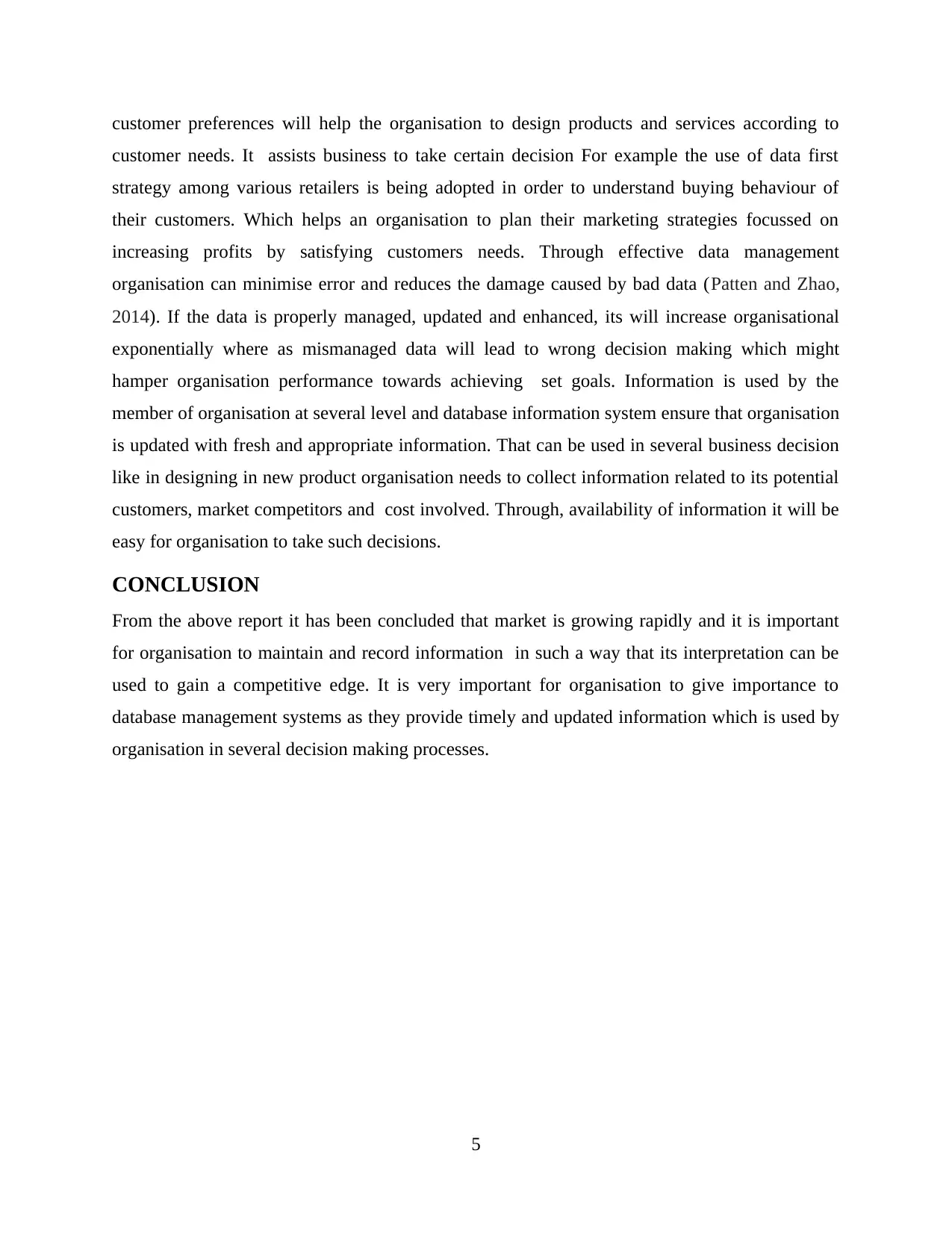
customer preferences will help the organisation to design products and services according to
customer needs. It assists business to take certain decision For example the use of data first
strategy among various retailers is being adopted in order to understand buying behaviour of
their customers. Which helps an organisation to plan their marketing strategies focussed on
increasing profits by satisfying customers needs. Through effective data management
organisation can minimise error and reduces the damage caused by bad data (Patten and Zhao,
2014). If the data is properly managed, updated and enhanced, its will increase organisational
exponentially where as mismanaged data will lead to wrong decision making which might
hamper organisation performance towards achieving set goals. Information is used by the
member of organisation at several level and database information system ensure that organisation
is updated with fresh and appropriate information. That can be used in several business decision
like in designing in new product organisation needs to collect information related to its potential
customers, market competitors and cost involved. Through, availability of information it will be
easy for organisation to take such decisions.
CONCLUSION
From the above report it has been concluded that market is growing rapidly and it is important
for organisation to maintain and record information in such a way that its interpretation can be
used to gain a competitive edge. It is very important for organisation to give importance to
database management systems as they provide timely and updated information which is used by
organisation in several decision making processes.
5
customer needs. It assists business to take certain decision For example the use of data first
strategy among various retailers is being adopted in order to understand buying behaviour of
their customers. Which helps an organisation to plan their marketing strategies focussed on
increasing profits by satisfying customers needs. Through effective data management
organisation can minimise error and reduces the damage caused by bad data (Patten and Zhao,
2014). If the data is properly managed, updated and enhanced, its will increase organisational
exponentially where as mismanaged data will lead to wrong decision making which might
hamper organisation performance towards achieving set goals. Information is used by the
member of organisation at several level and database information system ensure that organisation
is updated with fresh and appropriate information. That can be used in several business decision
like in designing in new product organisation needs to collect information related to its potential
customers, market competitors and cost involved. Through, availability of information it will be
easy for organisation to take such decisions.
CONCLUSION
From the above report it has been concluded that market is growing rapidly and it is important
for organisation to maintain and record information in such a way that its interpretation can be
used to gain a competitive edge. It is very important for organisation to give importance to
database management systems as they provide timely and updated information which is used by
organisation in several decision making processes.
5
Paraphrase This Document
Need a fresh take? Get an instant paraphrase of this document with our AI Paraphraser
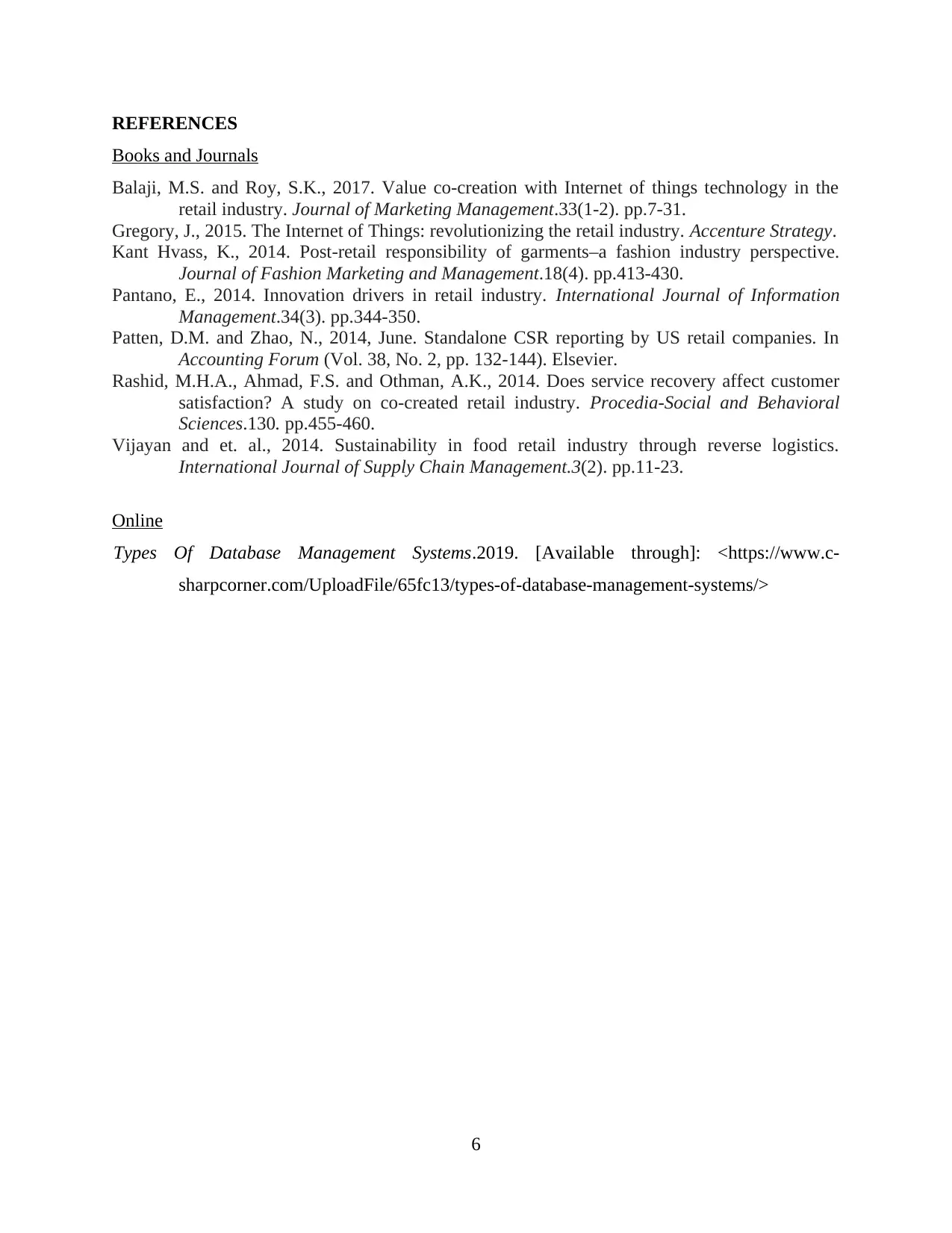
REFERENCES
Books and Journals
Balaji, M.S. and Roy, S.K., 2017. Value co-creation with Internet of things technology in the
retail industry. Journal of Marketing Management.33(1-2). pp.7-31.
Gregory, J., 2015. The Internet of Things: revolutionizing the retail industry. Accenture Strategy.
Kant Hvass, K., 2014. Post-retail responsibility of garments–a fashion industry perspective.
Journal of Fashion Marketing and Management.18(4). pp.413-430.
Pantano, E., 2014. Innovation drivers in retail industry. International Journal of Information
Management.34(3). pp.344-350.
Patten, D.M. and Zhao, N., 2014, June. Standalone CSR reporting by US retail companies. In
Accounting Forum (Vol. 38, No. 2, pp. 132-144). Elsevier.
Rashid, M.H.A., Ahmad, F.S. and Othman, A.K., 2014. Does service recovery affect customer
satisfaction? A study on co-created retail industry. Procedia-Social and Behavioral
Sciences.130. pp.455-460.
Vijayan and et. al., 2014. Sustainability in food retail industry through reverse logistics.
International Journal of Supply Chain Management.3(2). pp.11-23.
Online
Types Of Database Management Systems.2019. [Available through]: <https://www.c-
sharpcorner.com/UploadFile/65fc13/types-of-database-management-systems/>
6
Books and Journals
Balaji, M.S. and Roy, S.K., 2017. Value co-creation with Internet of things technology in the
retail industry. Journal of Marketing Management.33(1-2). pp.7-31.
Gregory, J., 2015. The Internet of Things: revolutionizing the retail industry. Accenture Strategy.
Kant Hvass, K., 2014. Post-retail responsibility of garments–a fashion industry perspective.
Journal of Fashion Marketing and Management.18(4). pp.413-430.
Pantano, E., 2014. Innovation drivers in retail industry. International Journal of Information
Management.34(3). pp.344-350.
Patten, D.M. and Zhao, N., 2014, June. Standalone CSR reporting by US retail companies. In
Accounting Forum (Vol. 38, No. 2, pp. 132-144). Elsevier.
Rashid, M.H.A., Ahmad, F.S. and Othman, A.K., 2014. Does service recovery affect customer
satisfaction? A study on co-created retail industry. Procedia-Social and Behavioral
Sciences.130. pp.455-460.
Vijayan and et. al., 2014. Sustainability in food retail industry through reverse logistics.
International Journal of Supply Chain Management.3(2). pp.11-23.
Online
Types Of Database Management Systems.2019. [Available through]: <https://www.c-
sharpcorner.com/UploadFile/65fc13/types-of-database-management-systems/>
6
1 out of 8
Related Documents
Your All-in-One AI-Powered Toolkit for Academic Success.
+13062052269
info@desklib.com
Available 24*7 on WhatsApp / Email
![[object Object]](/_next/static/media/star-bottom.7253800d.svg)
Unlock your academic potential
Copyright © 2020–2025 A2Z Services. All Rights Reserved. Developed and managed by ZUCOL.




